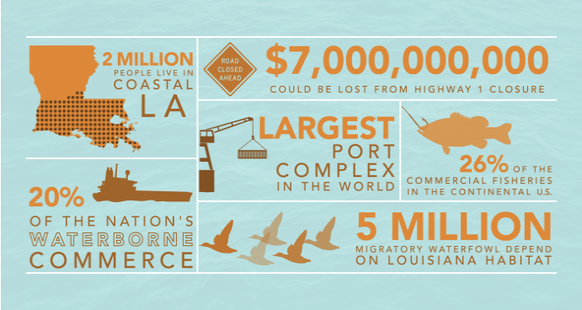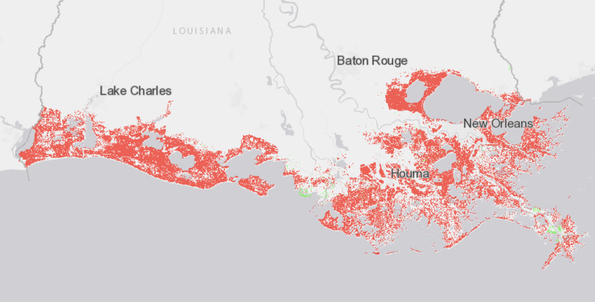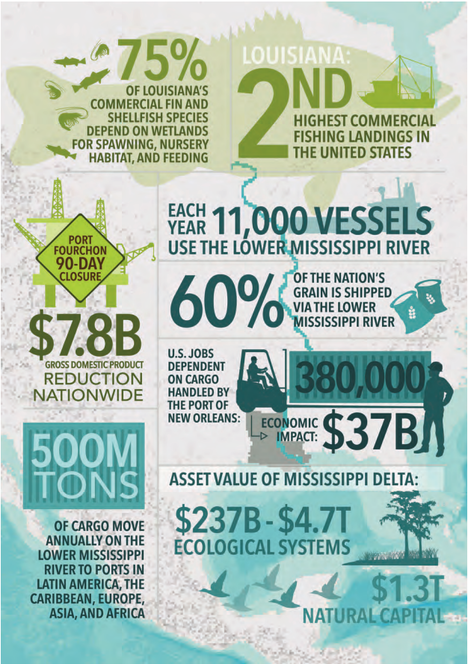Land Loss
We are losing around 25-35 square miles of wetlands each year. An area the size of Rhode Island could be under water by 2050. A scientific analysis confirmed that without action, we could lose up to another 4,120 square miles over the next 50 years.Historically, we have lost lost more than 1,800 square miles of land between 1932 and 2010.
Pictured below is a prediction model of what would happen with a future with no action.
We are losing around 25-35 square miles of wetlands each year. An area the size of Rhode Island could be under water by 2050. A scientific analysis confirmed that without action, we could lose up to another 4,120 square miles over the next 50 years.Historically, we have lost lost more than 1,800 square miles of land between 1932 and 2010.
Pictured below is a prediction model of what would happen with a future with no action.
|
Storm Buffers and Flood Protection
Louisiana's barrier islands are eroding at a rate of up to 20 meters per year; so fast that, according to recent USGS estimates, several will disappear by the end of the century. It is estimated that every 2.7 miles of wetlands reduces a storm surge by one foot. As erosion continues, and wetlands turn to open water, their ability to decrease approaching storm surges decreases and the risk of catastrophic loss of life and property from hurricanes is greatly increased. As the barrier islands disintegrate, the vast system of sheltered wetlands along Louisiana's delta plains are exposed to the full force and effects of open marine processes such as wave action, salinity intrusion, storm surge, tidal currents, and sediment transport that combine to accelerate wetlands deterioration. This cycle creates a loop where lost wetlands lead to lost barrier islands which lead to more lost wetlands. Due to lost wetlands and storm buffers, between 60 and 70% of Louisiana’s population, over 2 million people, will become increasingly vulnerable to flooding. Wildlife and Fish 66% of Gulf of Mexico sport and commercial fish species are dependent on coastal wetlands for their survival. Louisiana’s wetlands are home to some species that are on the endangered or threatened list. With rapid land loss, these marine species will lose their habitat and will eventually diminish. Sources estimate that by 2050, the annual loss in commercial fisheries due to eroding wetlands will be nearly $550 million. |

Oil and Gas Economy
The market value of interstate pipelines in Louisiana is over $2.4 billion. This value translates into 5,000 full-time jobs with an annual payroll of approximately $250 million. Over $103 billion in assets will be at risk and the transfer of petroleum products within Louisiana and to the rest of the nation will be disrupted. Coastal erosion will lead to exposed pipelines, destroying oil transfers and wildlife habitats.
Transportation and Navigation
Louisiana ranks first in the nation in total shipping tonnage, with 500 million tons of waterborne cargo passing through Louisiana's system of deep-draft ports and navigational channels. If present land loss rates continue, more than 155 miles of waterways and several of the ports will be exposed to open water within 50 years.
Overall Economic Challenges
Over a 100-year period, the value of the coast’s ecological services alone would be between $237 billion and $4.7 trillion. The Mississippi River Delta provides at least $12 billion to $47 billion in benefits to people each year. If this natural capital were treated like an economic asset, its total economic benefit to the nation would be $330 billion to $1.3 trillion per year. Moreover, data from past hurricanes indicates that the loss of every one-mile strip of wetlands along the coast, results in an estimated $5,752,816 average annual increase in property damage.
The market value of interstate pipelines in Louisiana is over $2.4 billion. This value translates into 5,000 full-time jobs with an annual payroll of approximately $250 million. Over $103 billion in assets will be at risk and the transfer of petroleum products within Louisiana and to the rest of the nation will be disrupted. Coastal erosion will lead to exposed pipelines, destroying oil transfers and wildlife habitats.
Transportation and Navigation
Louisiana ranks first in the nation in total shipping tonnage, with 500 million tons of waterborne cargo passing through Louisiana's system of deep-draft ports and navigational channels. If present land loss rates continue, more than 155 miles of waterways and several of the ports will be exposed to open water within 50 years.
Overall Economic Challenges
Over a 100-year period, the value of the coast’s ecological services alone would be between $237 billion and $4.7 trillion. The Mississippi River Delta provides at least $12 billion to $47 billion in benefits to people each year. If this natural capital were treated like an economic asset, its total economic benefit to the nation would be $330 billion to $1.3 trillion per year. Moreover, data from past hurricanes indicates that the loss of every one-mile strip of wetlands along the coast, results in an estimated $5,752,816 average annual increase in property damage.


